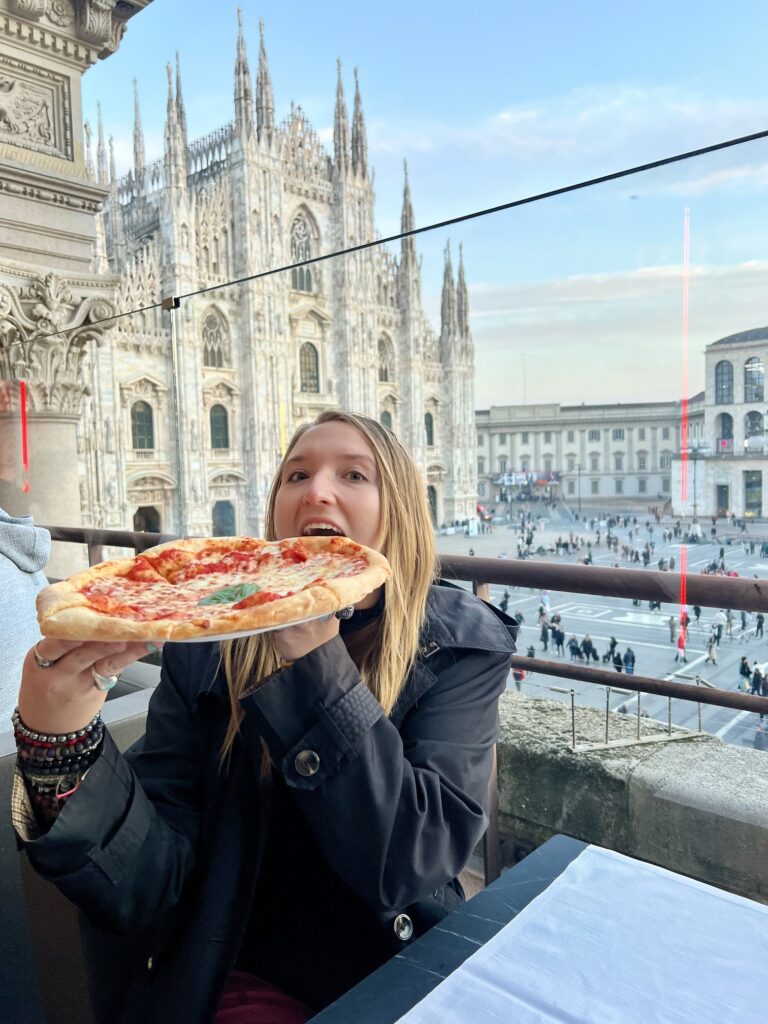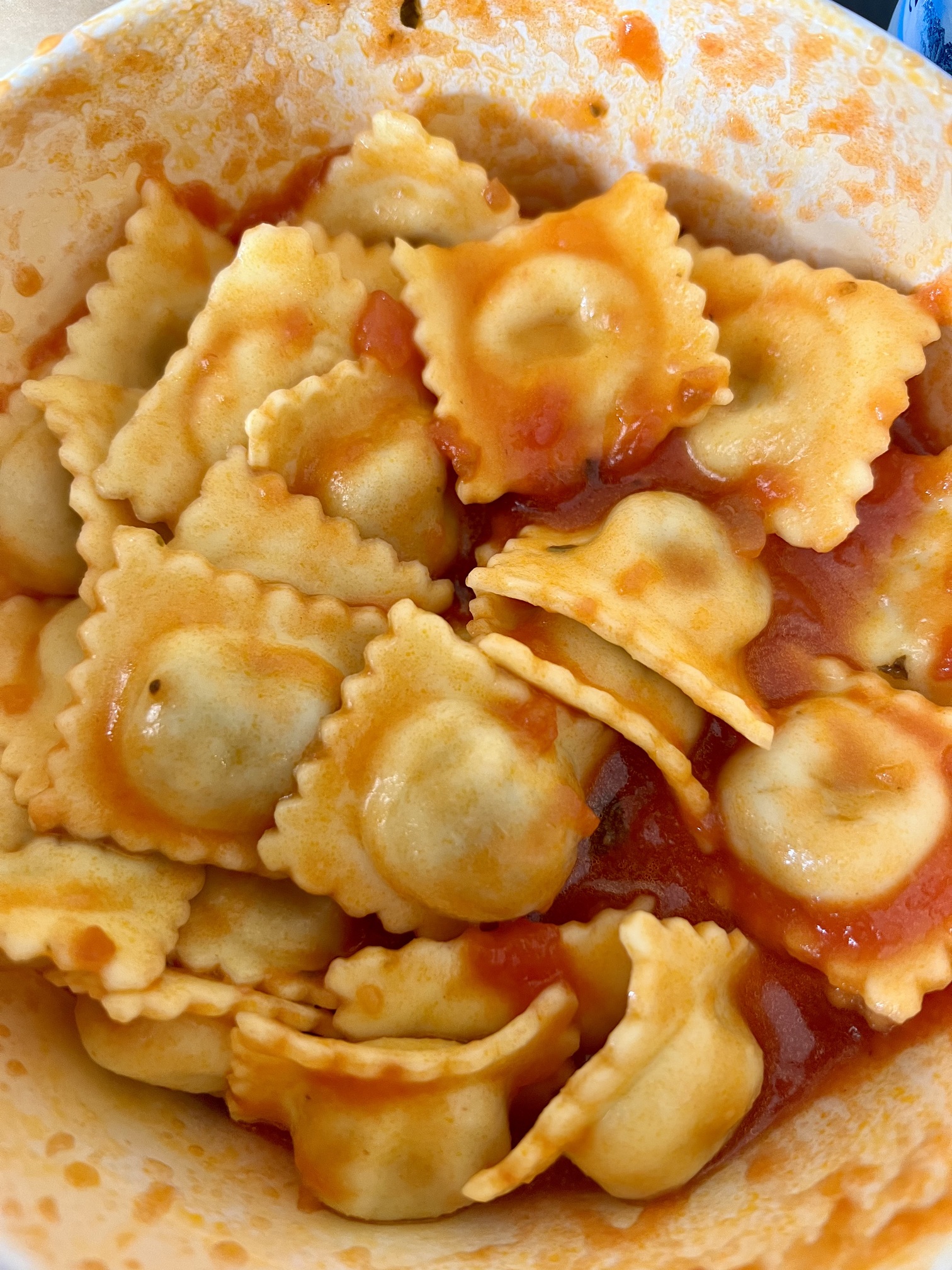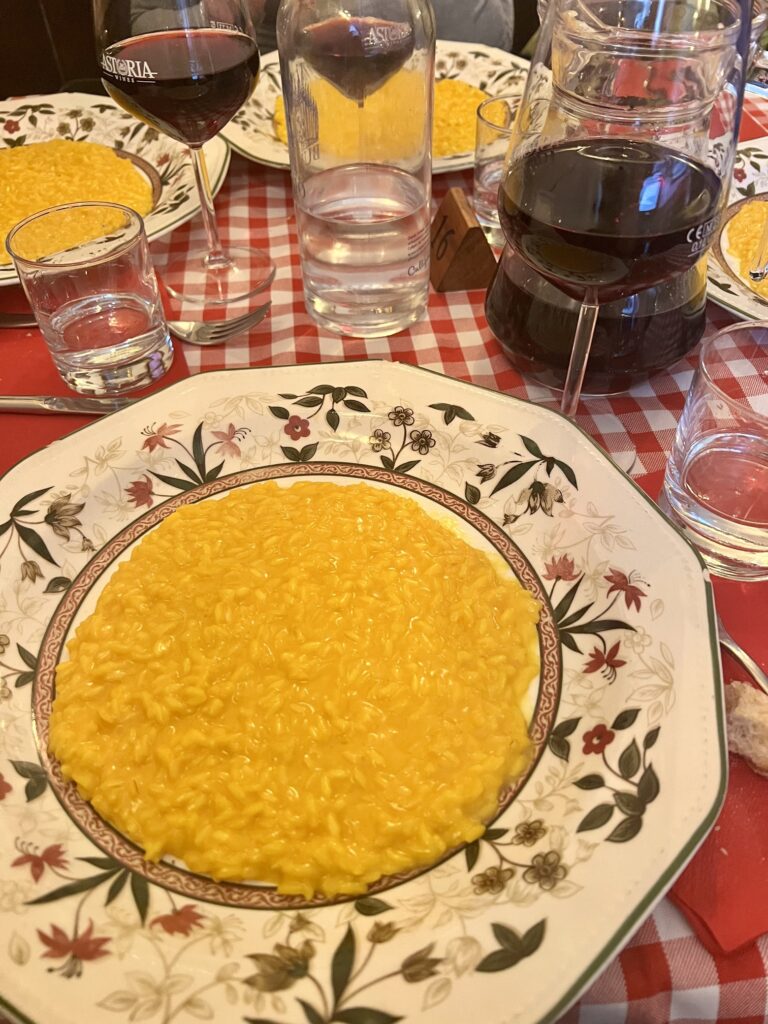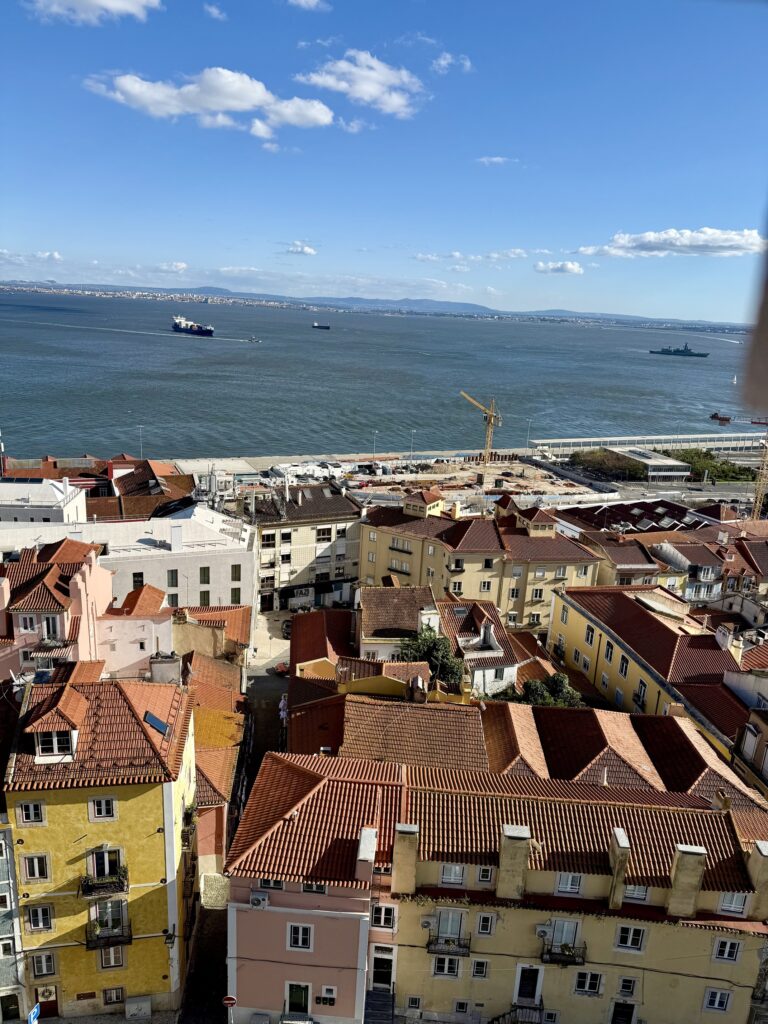
Authentic Italian Flavors: What Italian Food to Eat in Italy
 September 24
September 24
 22 min read
22 min read

Authentic Italian Flavors: What Italian Food to Eat in Italy-Key Highlights
- Learn about real Italian cuisine by trying 10 famous dishes from different parts of Italy.
- Enjoy the tasty flavors of foods like Pizza Margherita, Risotto al Nero di Seppia, and Tiramisu.
- Discover the cooking styles of Tuscany, Emilia Romagna, Lombardy, Sicily, and Veneto through their special dishes.
- Savor the ease of Italian street food with Ciabatta Sandwiches, Supplì, and Panzerotti.
- Find out the stories behind Italian foods like Polenta, Truffles, and Prosciutto di Parma.
- Enjoy the skill of making Italian pasta, good wine and cheese pairings, tasty desserts, and Italy’s coffee culture.
Introduction
Italy is well-known for its wonderful food, including various regional dishes. It has a wide range of tasty dishes for everyone. You can enjoy creamy risotto alla Milanese and rich lasagna Bolognese. Italian cuisine mixes flavors and traditions perfectly. Each region has its own special dishes. By exploring Italy through its food, you discover many amazing tastes. Let’s start a delicious journey through Italy’s variety of food. We will enjoy real flavors and learn the stories behind each dish. This will show us the heart of this beloved Italian cuisine.
10 Italian Foods You Must Try When in Italy
1. Pizza Margherita – The Quintessence of Italian Flavors
Enjoy the famous pizza margherita, which shows off the best of Italian cooking. This classic dish has a mix of tomato sauce, fresh mozzarella cheese, and fragrant fresh basil on a thin crust. It is topped with olive oil. Every bite brings out the beauty of simple foods and quality ingredients. You can taste it in a cozy pizzeria or a fancy trattoria. Pizza margherita is a must-try for anyone who wants to enjoy the real flavor of Italy. Have a slice of Italian culture with this timeless favorite.
2. Lasagna Bolognese – A Rich Layered Delight
Lasagna Bolognese is a tasty layered dish from Bologna, located in the Emilia Romagna region of Italy. This pasta dish is made with wide sheets of pasta, a rich Bolognese sauce that includes tomatoes and minced meat, and a creamy béchamel sauce. It is topped generously with Parmigiano Reggiano cheese. The mix of flavors and textures in this classic recipe gives a comforting and indulgent experience for people who love food. Lasagna Bolognese really shows what Italian cuisine is all about with its strong and satisfying taste.
3. Risotto al Nero di Seppia – A Venetian Specialty
Risotto al nero di seppia is a special dish from Venice. It uses cuttlefish ink, giving it a bold black color and a unique taste. This traditional Italian dish is known for its seafood flavor and creamy texture, often enhanced by adding bell pepper. It is made by slowly cooking Arborio rice in a tasty broth. Adding white wine, garlic, and olive oil improves the flavor. At the end, it is topped with parsley and Parmesan cheese for freshness. Risotto al nero di seppia shows the skill of Italian cuisine and offers a wonderful eating experience that comes from Venetian food traditions.
4. Gelato – Beyond Ordinary Ice Cream
Indulge in gelato. It is more than ordinary ice cream. Gelato has a creamy texture and rich flavors. This Italian dessert uses fresh ingredients like milk, sugar, and real fruit. You should definitely try it. Gelato has less air than traditional ice cream. This makes it denser and smoother. There are many flavors to choose from, like classic pistachio and exotic fruits. It has something for everyone. Whether you are walking on cobbled streets or enjoying a sunny day, having a scoop of gelato is the best way to enjoy Italy’s sweet side.
5. Tiramisu – The Iconic Italian Dessert
Tiramisu is a famous Italian dessert. It has layers of ladyfingers soaked in coffee and creamy mascarpone cheese. This treat is topped with cocoa, giving it a nice mix of bitter and sweet tastes. Tiramisu started in the Veneto region in the 1960s and soon became a favorite. Its name means “pick me up,” reflecting the coffee inside. Each creamy bite shows what Italian cuisine is all about. It is a dessert you should definitely try during your trips in Italy.
6. Ossobuco alla Milanese – A Slow-Cooked Masterpiece
Ossobuco alla Milanese is a traditional Italian dish from the Lombardy region, often referred to as osso buco. It is cooked slowly and has tender veal shanks. These shanks are braised with tasty ingredients like tomato sauce, white wine, and broth. A key part of this dish is the gremolata. This is a fresh mix of lemon zest, garlic, and parsley, which boosts the savory flavor. It is served over creamy risotto alla Milanese. This dish shows the richness and depth of Italian cuisine. Ossobuco alla Milanese truly showcases the cooking skills that make traditional Italian flavors special.
7. Caprese Salad – Simplicity at Its Best
The Caprese salad shows how simple Italian food can be great. This classic dish comes from the island of Capri. It uses main ingredients like fresh mozzarella cheese, ripe cherry tomatoes, and fragrant basil leaves. A drizzle of olive oil, a sprinkle of salt, and sometimes a touch of balsamic vinegar finish this light and refreshing salad. Its bright colors and flavors make it a favorite on restaurant menus and an easy choice for homemade Italian recipes. You can enjoy the freshness of this dish that highlights Italian cuisine perfectly.
8. Carbonara – A Roman Classic
Carbonara is a classic dish from Rome, and to ensure you’re getting the real deal, it is a creamy pasta dish made with eggs, Pecorino Romano cheese, guanciale or pancetta, and black pepper. You create the sauce by mixing raw eggs with hot pasta. The heat cooks the eggs and gives a smooth texture. Many think carbonara started in Rome, but its history is not very clear. People love this dish for its simple ingredients and rich flavors. It shows the best of traditional Roman food.

9. Arancini – Crispy Sicilian Snacks
Arancini are crispy snacks from Sicily. They are deep-fried rice balls packed with ragù, mozzarella, and peas. People in Sicily really enjoy these tasty bites. You can usually find them in local restaurants and on food tours. The name “arancini” comes from the Italian word “arancina,” which means orange. This is because the rice balls look like oranges. With their crunchy outside and tasty filling, arancini are a perfect example of the great food from Sicily. You can have them as a starter or a snack. They truly show off the rich food culture of the island in every tasty bite.
10. Focaccia – More Than Just Bread
Focaccia comes from Liguria. It is not just bread; it’s a special treat. This flatbread has olive oil and is sprinkled with salt, sometimes with herbs, or even leftover stale bread. It has a crunchy outside and a soft inside. Focaccia can be topped with cherry tomatoes, olives, or rosemary, making it very flexible. You can eat it as an appetizer, with a meal, or as a snack. Its simple look hides the rich flavors inside. Focaccia represents Italian cuisine well. It takes simple ingredients and makes something amazing. Make sure you try this tasty Italian dish when you explore Italy.
Exploring the Regions Through Their Foods
Tuscany is known for its great food, especially bistecca fiorentina and bistecca alla fiorentina. Emilia Romagna is famous for its balsamic vinegar and parmigiano reggiano. Lombardy offers tasty dishes like ossobuco alla milanese. Sicily’s food shows a mix of flavors from different cultures. Veneto is well-known for seafood and comfort foods, like risotto al nero di seppia. Each area in Italy has its own unique food style. This shows the rich and lively food culture of the country.
The Rich Culinary Traditions of Tuscany
Tuscany’s food culture is a great example of Italian cuisine. You can enjoy dishes like bistecca alla fiorentina and ribollita, a hearty soup, here. This area is famous for its delicious olive oil, strong pecorino cheese, and smooth Chianti wine. Don’t miss pappa al pomodoro, a tasty soup made with bread, ripe tomatoes, and basil. Try crostini di fegatini, a chicken liver spread served on crunchy bread. Also, treat yourself to cantucci e vin santo, which are almond cookies dipped in sweet wine, a favorite from Tuscany. Visit Tuscany’s food markets to truly taste Italian flavors.
Emilia Romagna: Home of Balsamic Vinegar and Parmigiano Reggiano
Emilia Romagna is often called the heart of Italian food. It is famous for two special foods: balsamic vinegar and parmigiano reggiano. The balsamic vinegar here is aged in wooden barrels for years. This gives it a unique sweet and tangy taste. It is great for salads or drizzling on meats. Parmigiano Reggiano is a hard cheese that comes from the rich fields of Emilia Romagna. It has a nutty and bold flavor. When you visit Emilia Romagna, make sure to enjoy these genuine specialties. Here, tradition and flavor come together. Taste the best of Italian food.
Lombardy: A Taste of Northern Italy
Lombardy is a place in northern Italy that offers a unique food experience. It is famous for its strong flavors and traditional recipes. One popular dish is Ossobuco alla Milanese. This dish features tender veal shanks cooked slowly in tomato sauce. You also have to try Risotto alla Milanese, a creamy rice dish with saffron that tastes wonderful. Enjoy these dishes with local white wine to get a real taste of Lombardy’s food. Discover the lively food scene in Lombardy and enjoy northern Italian cuisine.
Sicily: A Melting Pot of Flavors
Sicily is a place full of different flavors and has a special food tradition shaped by many cultures. You can find tasty arancini and sweet cannoli in Sicilian cooking. The island is close to the sea, which gives it plenty of fresh seafood. This leads to dishes like pasta con le sarde, which is pasta with sardines. The lively street markets are filled with fresh fruits and vegetables that are important for making meals like caponata. Caponata is a yummy sweet and sour eggplant stew. Sicily really delights the taste buds with its variety of tasty dishes.
Veneto: Where Seafood Meets Comfort Food
Venture to Veneto, where fresh seafood meets comforting flavors, just like the renowned dishes from the Amalfi Coast. Enjoy Sarde in saor, a tasty dish of sweet and sour sardines. Try Bigoli in salsa, which is thick spaghetti with a rich anchovy sauce. Savor the unique taste of Risotto al nero di seppia, a rich risotto made with black squid ink. The food in Veneto mixes sea and land, with meals like Baccalà mantecato showing off the skill with salted cod. Visit Veneto for a great mix of seafood and comfort food.
Italian Street Food: A Taste on the Go
Italian street food is a fast and tasty way to enjoy Italy’s cooking. You can find things like ciabatta sandwiches, which are popular for a quick meal, and supplì, a favorite fried snack in Rome. There are also panzerotti, which are crispy fried calzones from Puglia. Every bite reflects tradition and flavor. These easy-to-eat foods mix local ingredients with unique styles. They are great for sightseeing or walking through Italy’s lively streets. Enjoy the real taste and convenience of Italian street food. It shows the heart of Italian cooking in a simple and easy way.
Ciabatta Sandwiches: Italy’s Answer to Fast Food
Ciabatta sandwiches are a special fast food in Italy. They bring tasty flavors in a nice, easy-to-hold form. These sandwiches often use fresh ingredients like tomato sauce, olive oil, and mozzarella cheese. You can find different types, from the classic ones with prosciutto and mozzarella to modern choices that use local favorites. They are great for a quick meal you can eat anywhere. Ciabatta sandwiches show the best of Italian street food. They highlight the wide variety and the tasty creativity that Italy is famous for.
Supplì: Rome’s Beloved Street Snack
Supplì is a popular street snack in Rome that you don’t want to skip. These deep-fried rice balls are filled with tomato sauce and melted mozzarella cheese. Each bite is full of flavor. Supplì comes from the Lazio region and is loved by both locals and visitors. The outside is crunchy, and the inside is creamy, making it a tasty snack to eat while you walk. Whether you are on a food tour or visiting the charming streets, trying supplì will give you a real taste of Roman street food.
Panzerotti: Fried Calzones from Puglia
Panzerotti is a popular street food from Puglia. It gives a fun twist to the classic calzone. These are fried dough pockets filled with different ingredients like tomato sauce, mozzarella, and even ground meat or ham. They are crispy outside and hot inside, making them a great savory snack at any time. Whether you are walking around the streets or need a quick meal, enjoying these tasty treats lets you savor real Italian street food.

Italian Foods with a Story
Italy has a rich culinary history. The dishes are full of stories. For example, polenta has roots in the Middle Ages. Then there are the prized white truffles from the northern regions. Each bite reveals a piece of history.
Prosciutto di Parma has been aged by Benedictine monks since the 13th century. Carciofi alla giudia comes from Rome’s Jewish community. These traditional recipes have been passed down through the years. They show us how Italy’s culture has changed. Every meal invites us to take a trip back in time.
The Historical Roots of Polenta
Polenta is an important food in Italian cuisine today. It goes back to the 16th century. At first, it was simple food for peasants. People liked it because it was versatile and healthy. Polenta is made from maize flour. It was a hearty dish that gave lasting energy. In history, polenta showed strength during tough times. It showed how resourceful the Italian people were. Over time, polenta changed from a plain porridge to a gourmet dish. Now, it is often served with different meats, cheeses, and sauces. This change highlights the rich culinary heritage of Italy.
Truffles: Italy’s Underground Gems
Truffles are special treasures from Italy that add a rich, earthy flavor to food. These unique mushrooms grow close to tree roots and are highly valued in cooking. White truffles can be found in the Piedmont region, while black truffles grow in central Italy. They have a strong scent that makes even simple dishes like pasta and risotto taste amazing. Truffle hunting is a time-honored practice where dogs help find these gems, showing how Italian cuisine is linked to the land. Enjoying the distinct taste of truffles is a great way to savor Italy’s culinary delights.
Prosciutto di Parma: A Delicacy with Tradition
Prosciutto di Parma is a famous Italian ham with a rich history. It comes from Parma, which is in the Emilia Romagna region. This special ham is aged for more than a year through careful salting and air-drying. The end result is a soft texture that melts in your mouth and a sweet flavor that makes it unique. People often enjoy it sliced thin with fresh figs, aged cheese, or wrapped around fruit. Prosciutto di Parma represents Italy’s high standards for quality and great food. Its special taste and background make it a must-try for anyone who loves food.
The Art of Italian Pasta
Understanding Italian pasta is about more than just the noodles. It is about truly appreciating the many shapes, sizes, and textures that make Italian cuisine special. Each pasta dish, like spaghetti and ravioli, has its own story of tradition and change. Choosing the right pasta shape for the perfect sauce is its own kind of art. Classics such as cacio e pepe and risotto alla milanese show how simple ingredients can come together beautifully. Learning about Italian pasta takes you on a tasty journey through many years of cooking skills.
Understanding Different Pasta Shapes and Their Origins
Pasta has many shapes, and each one is great with certain sauces. For example, spaghetti goes well with tomato sauce, and penne is good for creamy sauces. Farfalle can catch bits of meat or veggies. Different shapes come from different places, like tagliatelle from Emilia Romagna, representing local customs. Orecchiette is from Puglia and means “little ears,” which is perfect for holding sauces. Some shapes, like conchiglie, look like seashells and go well with seafood dishes. From classic spaghetti to unique trofie, pasta shapes are important in Italian cuisine.
The Secret Behind the Perfect Pasta Sauce
Pasta sauce is very important in Italian cuisine. It can make a dish special. The key is using good ingredients and cooking them right. A traditional Italian pasta sauce has fresh tomatoes, olive oil, garlic, and basil. There are many different recipes in different regions, and each one has its special twist. Some recipes add a bit of red wine or a touch of chili pepper to spice things up. The most important thing is to let the sauce simmer slowly. This helps the flavors mix well. The result is a rich aroma that sticks nicely to the pasta.
Italian Wines and Cheeses: A Perfect Pairing
Italy is a dream come true for food lovers with its wonderful wines and cheeses. You can enjoy regional wines like Chianti or Barolo with aged Parmigiano Reggiano. This combination gives you a great taste. The strong flavor of Pecorino Romano goes well with a rich glass of Sangiovese. To really enjoy Italy, try Pecorino Toscano with Vernaccia di San Gimignano. Whether you like bold red wines from Tuscany or crisp white wines from Veneto, each sip with Italian cheese feels like a trip to beautiful vineyards and hills in Italy.
Exploring Italy’s Wine Regions
In Italy, visiting wine regions is a fun adventure. You will find many different places with their own special grapes and ways to make wine. In Tuscany, the Chianti Classico, made with Sangiovese grapes, goes great with local dishes like bistecca alla fiorentina. If you go north to Veneto, you can enjoy Prosecco in the best place, the pretty town of Valdobbiadene. Sicily has volcanic wines like Etna Rosso that show the island’s fiery history. Whether you drink Barolo in Piedmont or Amarone in Veneto, Italy’s wine regions give you a taste of old traditions in every sip.
Cheese Varieties You Must Try
Pecorino Romano is a tasty hard cheese from Southern Italy. Cheese lovers should definitely try it. Parmigiano Reggiano, called the “King of Cheeses,” comes from the Emilia Romagna region and is made from cow’s milk. It has a rich and nutty flavor. Fresh Mozzarella di Bufala is a soft cheese made from buffalo milk. It comes from Campania and is very creamy. Gorgonzola, a blue cheese from Lombardy, has a sharp and tangy taste. Trying these Italian cheeses will make your food experience in Italy richer and more real. Enjoy all these great flavors!

Italian Desserts: Ending Your Meal on a Sweet Note
Panna Cotta: A Silky Smooth Dessert
Panna cotta is a smooth and creamy dessert from Italy. It is a treat for those who love sweets. This dessert usually has cream, sugar, and gelatin, giving it a rich taste that melts in your mouth. It is often topped with fruit sauce or caramel, making it a great ending to an Italian meal. The name “panna cotta” means “cooked cream,” showing how simple its preparation is. Panna cotta can also have flavors like vanilla or coffee, which makes it a favorite dessert for many people around the world.
Cannoli: Sicily’s Sweet Staple
Cannoli are a popular sweet from Sicily. They have crispy shells that hold creamy ricotta cheese inside. These pastries came from Sicily and are a must-try if you love Italian desserts. The filling is smooth and can be made with sugar, chocolate chips, or candied fruit. The fried dough shell is crunchy, making it a great match with the sweet filling. Cannoli are a special treat from Sicily. They balance sweetness and crunch, showing off the skill of Italian bakers with every bite.
Italian Coffee Culture
Espresso is an important part of Italian coffee culture. It’s more than just a drink; it’s a way of life. People enjoy it in small, quick shots. This shows the real spirit of Italian coffee. Knowing the rules of coffee drinking in Italy is important. For example, it’s common to skip milk in your espresso after dinner. Italians prefer good taste over large sizes. They like strong flavors. Making coffee is a skill that Italian baristas take very seriously. Whether you are in a warm café or a busy bar, having espresso in Italy is a unique experience.
Espresso: More Than Just a Coffee
Espresso is a strong coffee that is rich and full of flavor. It comes from Italy and is often enjoyed after meals. Making espresso involves pushing hot water through finely-ground coffee beans. This creates a strong and intense drink. Besides giving you energy, espresso is a symbol of Italian hospitality. Cafes are places where people gather to talk and relax. So, espresso is more than just a drink; it is an important part of Italian coffee culture.
Understanding Italy’s Coffee Etiquette
In Italy, coffee is more than just a drink; it’s part of the culture. When you order coffee, keep in mind that cappuccinos are only for breakfast. During the day, choose an espresso. If you want something with milk later, order a macchiato. Standing at the bar is cheaper than sitting at a table. Avoid asking for a flavored latte; Italians like their coffee plain. Also, don’t order coffee to go; it should be enjoyed slowly. Soak in the lively atmosphere of Italian coffee bars and enjoy your espresso like a local.
The Role of Fresh Ingredients in Italian Cooking
Italian cooking focuses a lot on fresh ingredients, which makes dishes taste better. Ripe cherry tomatoes, fragrant basil, and a splash of extra virgin olive oil can change a basic pasta dish into something special. Freshness is also crucial in caprese salad, thanks to juicy mozzarella cheese, and in seafood risotto, where vibrant lemon juice plays a key role. The Primi, or first course, in Italian cuisine is all about the quality of ingredients. It’s important to use local, seasonal produce to make authentic and tasty dishes.
From Farm to Table: The Importance of Fresh Produce
Italy’s famous cooking is all about the farm-to-table way of thinking. This means fresh ingredients, such as green beans, are really important. From the green fields in Tuscany to the seaside gardens in Sicily, Italian dishes use local foods to keep their real taste. The bright tomatoes for the well-known tomato sauce, the lovely basil for pesto, and the tangy lemons for seafood all highlight what Italian cooking is about. This link to the land makes sure that each meal shows the true spirit of “cucina povera,” which is the simple but tasty Italian food.
Seafood in Italian Cuisine: A Coastal Heritage
Italy’s food is closely linked to the sea. Seafood is very important in Italian cooking. You can find fresh seafood from the Tyrrhenian Sea to the Adriatic Coast. Dishes like seafood pasta and fritto misto include scampi, squid, and anchovies. In Sicily, they offer special dishes like sarde a beccafico, which are stuffed sardines. These meals reflect the true taste of the Mediterranean. Whether you are eating at a cozy seaside trattoria or a busy city ristorante, enjoying seafood in Italian cuisine is a great way to explore the wonderful coastal flavors of Italy.
Conclusion
Dive into the amazing food of Italy with its many local meals. Each dish takes you on a journey into the heart of Italian cuisine. You can try the creamy risotto alla milanese or enjoy a simple Caprese salad. Every bite shares a story of culture and taste. Don’t miss the lively street food like Ciabatta sandwiches and Supplì. End your meal with delicious Panna Cotta for a sweet touch. Enjoy the rich traditions of Italian cooking, where every dish is made with care and history. Buon appetito!
For more information, visit my Complete Travel Guide to Italy!
Frequently Asked Questions
What is Traditional Italian Pizza Like?
Traditional Italian pizza has a thin crust and just a few toppings. It uses high-quality ingredients, like San Marzano tomatoes and fresh mozzarella. It is cooked in a wood-fired oven, which gives it a crispy but chewy texture. This pizza shows simplicity and true, authentic flavors.
How Do I Order Coffee in Italy Like a Local?
In Italy, if you want coffee, say “un caffè” for an espresso. If you want a cappuccino, ask for “un cappuccino,” but only in the morning. Stand at the bar to drink quickly. This way, you will pay less than if you sit at a table. Thank you!
Can I Find Vegetarian Options in Italian Cuisine?
Enjoy a range of tasty vegetarian dishes in Italian cuisine. You can try classic Margherita pizza and smooth risotto. Don’t miss out on tasty options like Caprese salad and rich desserts such as tiramisu. Italian cuisine has many delicious meat-free choices for everyone.
What Are Some Must-Visit Food Markets in Italy?
Discover real Italian tastes at these food markets in Italy. You should visit Mercato Centrale in Florence and Mercato di Rialto in Venice. Enjoy the lively atmosphere and taste fresh fruits and vegetables, special cheeses, and local dishes.
Considering a Visit to Italy? Check Out My Other Articles:
Recent Posts
Related Posts
Fado Portugal: Portugal’s Soulful Musical Tradition
Fado Portugal- Key Highlights Introduction Portuguese music is varied and full of life. Fado is its most…
Best Places to Visit in Portugal: Bucket List Destinations
Best Places to Visit in Portugal- Key Highlights Introduction Get ready to fall in love with Portugal…
Mineral Springs Saratoga Springs NY: Nature’s Wellness Oasis
Mineral Springs Saratoga Springs- Key Highlights Introduction Saratoga Springs is a city full of history and famous…




